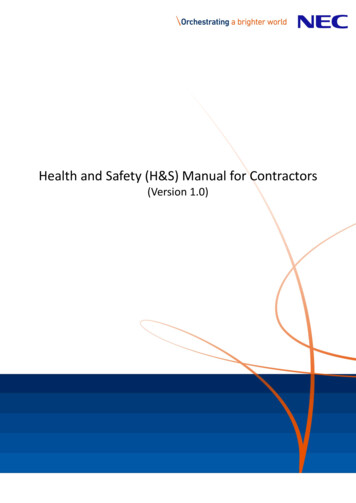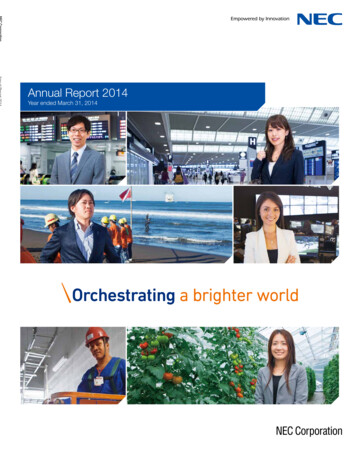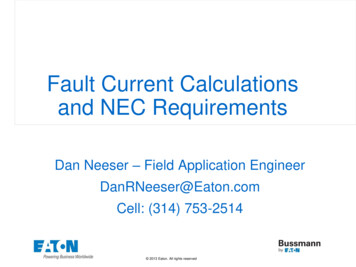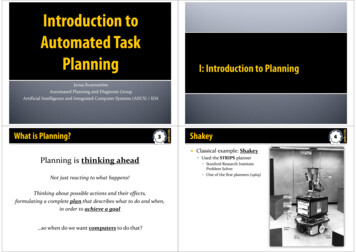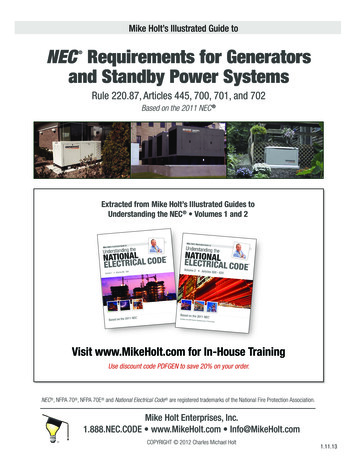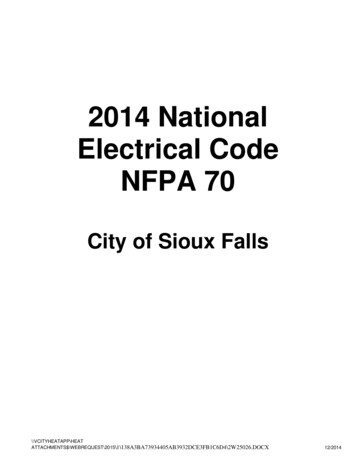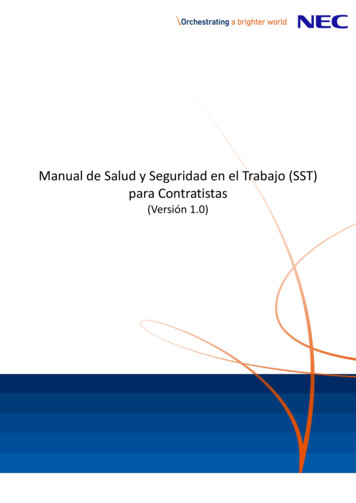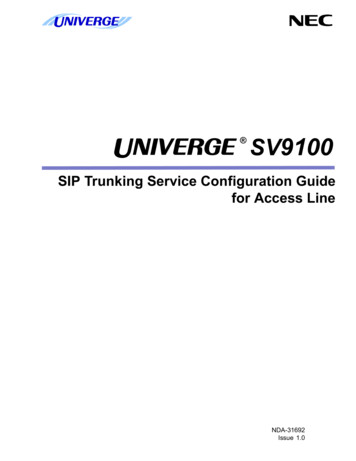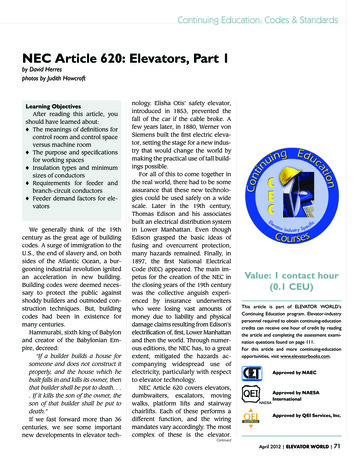
Transcription
Continuing Education: Codes & StandardsNEC Article 620: Elevators, Part 1by David Herresphotos by Judith HowcroftLearning ObjectivesAfter reading this article, youshould have learned about: The meanings of definitions forcontrol room and control spaceversus machine room The purpose and specificationsfor working spaces Insulation types and minimumsizes of conductors Requirements for feeder andbranch-circuit conductors Feeder demand factors for elevatorsWe generally think of the 19thcentury as the great age of buildingcodes. A surge of immigration to theU.S., the end of slavery and, on bothsides of the Atlantic Ocean, a burgeoning industrial revolution ignitedan acceleration in new building.Building codes were deemed necessary to protect the public againstshoddy builders and outmoded construction techniques. But, buildingcodes had been in existence formany centuries.Hammurabi, sixth king of Babylonand creator of the Babylonian Empire, decreed:“If a builder builds a house forsomeone and does not construct itproperly, and the house which hebuilt falls in and kills its owner, thenthat builder shall be put to death. . . If it kills the son of the owner, theson of that builder shall be put todeath.”If we fast forward more than 36centuries, we see some importantnew developments in elevator tech-nology. Elisha Otis’ safety elevator,introduced in 1853, prevented thefall of the car if the cable broke. Afew years later, in 1880, Werner vonSiemens built the first electric elevator, setting the stage for a new industry that would change the world bymaking the practical use of tall buildings possible.For all of this to come together inthe real world, there had to be someassurance that these new technologies could be used safely on a widescale. Later in the 19th century,Thomas Edison and his associatesbuilt an electrical distribution systemin Lower Manhattan. Even thoughEdison grasped the basic ideas offusing and overcurrent protection,many hazards remained. Finally, in1897, the first National ElectricalCode (NEC) appeared. The main impetus for the creation of the NEC inthe closing years of the 19th centurywas the collective anguish experienced by insurance underwriterswho were losing vast amounts ofmoney due to liability and physicaldamage claims resulting from Edison’selectrification of, first, Lower Manhattanand then the world. Through numerous editions, the NEC has, to a greatextent, mitigated the hazards accompanying widespread use ofelectricity, particularly with respectto elevator technology.NEC Article 620 covers elevators,dumbwaiters, escalators, movingwalks, platform lifts and stairwaychairlifts. Each of these performs adifferent function, and the wiringmandates vary accordingly. The mostcomplex of these is the elevator.Value: 1 contact hour(0.1 CEU)This article is part of ELEVATOR WORLD’sContinuing Education program. Elevator-industrypersonnel required to obtain continuing-educationcredits can receive one hour of credit by readingthe article and completing the assessment examination questions found on page 111.For this article and more continuing-educationopportunities, visit www.elevatorbooks.com.NATIONAL ASSOCIATIONOF ELEVATOR CONTRACTORS Approved by NAECCERTIFIEDELEVATOR TECHNICIANEDUCATION PROGRAMApproved by NAESAInternationalApproved by QEI Services, Inc.ContinuedApril 2012 ELEVATOR WORLD 71
Continuing Education: ContinuedWhen you consider that an elevator is an enclosed roomwith one or more doors that people voluntarily enter sothey may travel hundreds of feet up or down, several observations are in order. Weight (passengers, freight, carand attendant machinery) may be fairly substantial, andspeed is significant. Many undertake trips in these devicestwo or more times daily in full confidence that they willsurvive an uneventful experience with a minute chance ofdisaster or even inconvenience. Elevator travel is far saferthan an automobile trip, and the chance of experiencingdisaster is on the order of being struck by lightning inone’s own backyard. Indeed, most elevator accidents involve maintenance workers, yet even theirs is not an excessively dangerous profession.Part of the reason that elevator usage is extraordinarilysafe is that construction and maintenance are regulatedby the wonderfully robust ASME A17.1 2007/CSA B44-07Safety Code for Elevators and Escalators, which containsoverall construction and maintenance requirements –everything from seismic mandates to machine-room lighting.A little more narrowly focused (yet of great consequence)is the ubiquitous NEC, which, in the National Fire ProtectionAssociation (NFPA)’s venerable Handbook edition, devotes18 double-column pages to electrical design and installation requirements for elevators, escalators and relatedequipment. These requirements, found in Article 620 (partof Chapter 6, Special Equipment), are in addition to NECChapters 1-3, which stipulate general wiring protocolsapplicable in most residential, commercial and industrialvenues.The code exempts some fairly broad areas where compliance is not expected. For example, wiring that is underexclusive utility control and has to do with the generationand distribution of electrical power is not NEC regulated.Here, the National Electrical Safety Code has jurisdiction.Utility-owned electrical structures not directly concernedwith electrical generation, transmission and distributionare NEC regulated. An example would be the elevator, aswell as all wiring in a utility-owned administration building. Similarly, underground wiring in mines is not NECregulated, although other, non-mine wiring below ground(such as lighting in an underground traffic tunnel) is covered.The electrical conductors and equipment for non-mineelevators that extend below grade are under NEC jurisdiction.It is also worth mentioning that the stated purpose ofthe NEC is the practical safeguarding of persons and property from hazards arising from the use of electricity. Thetwo primary hazards are fire and electric shock or arcflash, although there are others. For example, an inadequately supported ceiling fan could fall and cause injuryor property damage. The code is not concerned with theContinued72 WWW.ELEVATORWORLD.COM April 2012
Continuing Education: Continuedefficiency or sophistication of equipment that it covers,except insofar as safety (in terms of human injury andproperty damage) is concerned.Many professionals believe the NEC is applicable onlyfor voltages over a certain level, but that is not the case.Even non-composite fiber-optic cable, which does notcarry electrical energy, is subject to the code. This is because the material may contribute fuel to a fire that hasoriginated elsewhere. The fire loading resulting from anaccumulation of abandoned low-voltage cabling may beconsiderable, and has to be understood and dealt with.This is especially true in an elevator shaft where measureshave to be taken to ensure that a hazardous situation isnot created.We shall now take a look at the principle requirementsof Article 620, with particular emphasis on wiring requirements for elevator shafts, machine rooms and cars. NECarticles generally adhere to a template, which greatly aidsin navigating and quickly locating mandates as neededfor project design or, on an installation level, in the field.Article 620 follows this pattern by opening, in Section I,General, with a statement of scope and definitions applicable to the topic under consideration. It is noted that thearticle covers the installation of electrical equipment andwiring for elevators, dumbwaiters, escalators, movingwalks, platform lifts and stairway chairlifts. This is somewhat broader than A17.1-2007/B44-07. Nevertheless, theprimary NEC focus is on elevators, and the intention is tomitigate the hazards associated with the use of electricity.(ASME has a separate document, A18.1-2008 Safety Standardfor Platform Lifts and Stairway Lifts). NEC has a further notethat the term “wheelchair lift” has been changed to “platform lift.”Article 620’s “Definitions” section includes two termsthat describe spaces not attached to the outside of a hoistway. These are: remote machine room and control room(for elevator and dumbwaiter), and remote machineryspace and control space (for elevator and dumbwaiter).They are differentiated from other similar structures bythe fact that they are not attached to the outside perimeter or surface of the walls, ceiling or floor of the hoistway.In a time when increasing value is placed on even smallamounts of real estate, elevator design must strive toconfigure, efficiently control and drive elements to whatever degree possible, and that is the thinking behind somealternate locations for these structures.Such design innovations require sophisticated wiringstrategies. Traditional wiring methods and materials comeinto play, as always, but it is necessary to rethink theirdeployment. The 12 definitions provided in NEC 2011,Section 620.2 are the place to start for guidance in thisContinued74 WWW.ELEVATORWORLD.COM April 2012
Continuing Education: Continuedarea, and the sections that follow lay out implementationguidelines that are very relevant in today’s environment.It is worth noting that these NEC terms, used throughoutArticle 620, have been chosen to correlate with A17.12007 usage. The two documents are in harmony andshould be used in conjunction.Other terms defined in NEC Article 620 are Control System,Motion Controller, Motor Controller, Operation Controller, Operating Device and Signal Device. While the definitions are straightforward, their deployment in real-lifebuilding projects involves enormous legal and moral implications, given the fact that we are carrying large numbersof people hundreds of feet above the earth’s surface on adaily basis.Many NEC articles address voltage limitations, and Article620 is no exception. Generally, it is decreed that the supply voltage is not to exceed 300 V between conductors(allowing for the familiar 240-V concept), although thereare exceptions. You may go up to 600 V for power circuitssupplying door-operator controllers and door motors,branch circuits and feeders to motor controllers, drivingmachine motors, machine brakes and motor-generatorsets. It is worth mentioning that when 600 V is talkedabout as a limit in the NEC, it is generally meant that thefamiliar 600-V nominal-voltage system is considered tolie within the permitted zone, making it a common usage.It is further stipulated that internal voltages of powerconversion equipment and functionally associated equipment, and the operating voltages of wiring interconnectingthe equipment, are permitted to be higher, provided thatthe equipment and wiring are listed for the higher voltages.Where voltages exceed 600, a sign reading “DANGER –HIGH VOLTAGE” is required. Heating and air-conditioningequipment located on the car must not be in excess of 600V. All live parts of electrical apparatuses are to be enclosedto protect workers and the public against accidental contact.Working spaces for electrical equipment that may haveto be examined, adjusted, serviced or maintained is required in all occupancies in an earlier NEC section,110.26(A). This requirement applies to all controllers, disconnecting means and other electrical equipment thatmay need servicing, inspection or maintenance. The mainconcern is to ensure that workers may escape to safety inthe awful circumstance of an arc-fault event.The usual scenario for electrical injury is shock – whenelectrical current passes through the human body. A different occurrence involves exposure to the explosiveblast when there is a line-to-line or line-to-ground arcblast. The electrical energy does not traverse the humanbody, but proximity to the explosion means severe injury76 WWW.ELEVATORWORLD.COM April 2012is possible from the intense heat and concussive shockwave. After such an event, it is important that the affectedworker is able to escape the area and get to help. For thisreason, the NEC provides for adequate working spacearound electrical equipment that may need to be serviced.The basic requirement is for minimum clear distances ofvarious depths for equipment operating at 600 V or less,nominal, depending upon voltage to ground and lateraldistance to insulated or grounded surfaces or exposedlive parts (not an issue in elevator machine rooms). Thisclear working space must be 30 in. wide or the width ofthe equipment, whichever is greater. It need not be exactlycentered on the equipment, and working spaces of adjacent pieces of equipment may overlap. In all cases, theworking space must permit at least a 90 opening ofequipment doors or hinged panels.As for height, the working space must extend from thegrade, floor or platform to 6-1/2 ft. or the height of theequipment, whichever is greater. Additional requirementsconcern escape routes. A second door is required if theequipment is rated over 1200 amps and over 6 ft. wide.Doors must open in the direction of travel and be equippedwith panic bars, pressure plates or other devices that arenormally latched but open under simple pressure. Thethinking behind this requirement is that the injuredworker could have severe hand burns and be unable tooperate a conventional doorknob. In an elevator machineroom, where space may be limited in the first place, theworking-space mandate must be factored in very early inthe design process lest an unthinkable amount of reworkbe necessary. Moreover, it is necessary to consider futureworker safety for an indefinite period.ContinuedInterior of an elevator motor controller: the motor circuit conductors are the heavywires at lower right. To the left are printed circuit boards with microprocessors thatgovern elevator performance.
Continuing Education: ContinuedPower coming into the machine room with a ground-fault circuit interrupter-protected receptacle on a dedicated circuit as required.Part II of Article 620 concerns conductors used in elevatorwork, and several important requirements are covered.Hoistway door interlock wiring from the riser must be flameretardant and have insulation suitable for a temperaturenot less than 200 C (392 F), much higher than that requiredfor most raceway or cable applications. Thus, the need fordoor interlock functionality is recognized.Similarly, the integrity of the traveling cable is emphasized. Acceptable types of wire for this application are givenin Table 400.4, which occurs in an earlier chapter and listsvarious types of elevator cable for lighting and control inboth unclassified and hazardous locations. NEC 2011 Article620.21(2)(b) states that hard-service cords and juniorhard-service cords that conform to the requirements ofArticle 400 (Table 400.4) are permitted as flexible connections between the fixed wiring on the car and devices onthe car doors or gates. (“Hard-service” and “junior hardservice” are trade names that apply to over 30 types offlexible cord, all beginning with the letter S. They havevarying properties, such as oil resistance, and various78 WWW.ELEVATORWORLD.COM April 2012material compositions for insulation, such as a thermoplastic elastomer. Many of these are for portable lighting.)To achieve flexibility and endurance, traveling cable ismore finely stranded and, where possible, separated intodiscrete conductors. One way to achieve this is by paralleling wires, i.e., connecting the runs at both ends so theyare physically like two wires but electrically one. Thisstrategy works to improve the flexibility of the travelingcable, but it is contrary to a general NEC rule concerningthe paralleling of conductors, which is generally done invery large sizes to avoid unwieldy wire pulls and terminations. In driving through commercialized suburban areas,you frequently see paralleled conductors for large retailgrocers (where there is a heavy refrigeration load). TheNEC rule specifies that the minimum size for paralleledconductors is 1/0 AWG, which is much too big for an elevator traveling cable. Accordingly, for this application,the minimum size is reduced to 20 AWG for lighting circuits.Feeder and branch-circuit conductors are required tohave specified ampacities: Conductors supplying a single motor are to have anampacity not less than the percentage of motor nameplate current determined from Section 430.22(A) and(E). Elevator motors are inherently intermittent duty.Moreover, because motors have a higher starting current than other loads, the overcurrent protection protocol is unique to them and somewhat counterintuitive. Ifthe entire feeder/branch circuit assembly were to beprotected in the conventional manner, the motor wouldcut out long before reaching operating speed. Accordingly, the supply wires are protected only for short circuit, and the overload protection is provided closer tothe motor. Conductors supplying a single motor controller are tohave an ampacity not less than the motor controllernameplate current rating plus all other connected loads.ContinuedHydraulic reservoir characteristic of a hydraulic-piston-operated elevator. With heavyuse on a hot day, the oil can overheat, causing elevator shutdown. This may becountered by providing good machine-room ventilation. The fan should be on adedicated circuit.
Continuing Education: Continued Conductors supplying a single power transformer areto have an ampacity not less than the nameplate current rating of the power transformer plus all other connected loads. Conductors supplying more than one motor, motorcontroller or power transformer are to have an ampacity not less than the sum of the nameplate current ratings of the equipment plus all other connected loads.Feeder conductors of less ampacity are permitted forgroup installations and quite common in elevator work.The demand factors are given in Table 620.14, which allows significant reductions as the number of motors is increased. The demand factor ranges from 1.00 for one elevator on a single feeder to 0.72 for 10 or more elevatorson a single feeder. The idea is quite simple. As greaternumbers of elevators are added, the likelihood of them alloperating simultaneously decreases so that it is permissible to reduce the feeder ampacity.Number of ElevatorsDemand on a SingleFeeder 310 or more0.72Table 620.14: Feeder Demand Factors for ElevatorsPart III, Wiring, looks at the types of wiring that may beinstalled in hoistways, cars, machine rooms and relatedspaces. The basic wiring methods are rigid-metal, rigidnonmetallic or intermediate-metal conduit; electrical metallic or rigid nonmetallic tubing; wireways; or Type MC,MI or AC cable, unless otherwise permitted. The travelingcable, of necessity, is exempted.Three wiring categories within hoistways are allowedin addition, each with exceptions. Cables used in Class 2power-limited circuits are permitted between risers andsignal equipment and operating devices, provided they aresupported and protected from physical damage and are ofthe jacketed and flame-retardant type. Flexible cords andcables part of listed equipment operating at 30 V (42 VDC)or less, similarly supported and protected, jacketed andflame retardant, are permitted. In hoistways not longerthan 6 ft., these additional wiring methods are permitted: Flexible metal conduit Liquid-tight flexible metal conduit80 WWW.ELEVATORWORLD.COM April 2012 Liquid-tight flexible nonmetallic conduit Flexible cords and cables, or conductors grouped together and taped or corded, are permitted withoutraceway, where they are part of listed equipment, adriving machine or a driving-machine brakeA sump or oil-recovery pump located in the pit is permitted to be cord connected. The cord is to be a hard-usage, oil-resistant type not over 6 ft. in length. Within cars,these additional wiring methods are permitted: Flexible metal conduit, liquid-tight flexible metal or nonmetallic conduit, 3/8 in. or larger, not over 6 ft. in length Hard-service cords and junior hard-service cords arepermitted as flexible connections between the fixedwiring on the car and devices on the car doors or gates.Hard-service cords are permitted only as flexible connections for the top-of-car operating device or the cartop work light.The following additional wiring methods are permittedon the car assembly in lengths not exceeding 6 ft.: Flexible metal conduit Liquid-tight flexible metal conduit Liquid-tight flexible nonmetallic conduit Flexible cords and cables (same conditions as withinhoistways)Within machine rooms, these additional wiring methodsare permitted: Flexible metal, liquid-tight flexible metal or liquid-tightflexible nonmetallic conduit 3/8 in. or larger, not exceeding 6 ft. in length, are permitted between control panelsand machine motors, machine brakes, motor-generatorsets, disconnecting means and pumping motors andvalves. An exception provides that liquid-tight flexiblemetal conduit or liquid-tight flexible nonmetallic conduit3/8 in. or larger is permitted to be installed in lengthsin excess of 6 ft. Where motor-generators, machine motors or pumpingunit motors and valves are located adjacent to or underneath control equipment and provided with extra-lengthterminal leads not exceeding 6 ft. in length, such leadsare permitted to be extended to connect directly tocontroller terminal studs without regard to carryingcapacity requirements. Auxilliary gutters are permittedin machine and control rooms between controllers,starters and similar apparatuses. Flexible cords and cables that are components of listedequipment and used in circuits operating at 30 V (42VDC) or less are permitted in lengths not to exceed 6ft., provided the cords and cables are supported andprotected from physical damage and are of a jacketedand flame-retardant type. On existing or listed equipment, conductors are permitted to be grouped together and taped or corded withoutbeing installed in a raceway. Such cable groups are toContinued
Arc-Flash Hazardsand Electrical SafeWork Practicesby The NEII Safety CommitteeThis position paper is written to provide guidance to members whose employees are engagedin elevator-industry work that might expose themto arc-flash hazards, and to assist members incomplying with applicable OSHA and NationalFire Protection Association (NFPA) standards. Asrecommended in NFPA 70E, the National ElevatorIndustry, Inc. (NEII) commissioned an arc-flashhazard analysis (in compliance with IEEE Standard 1584-2002 for procedures for calculating theincident energy of the arc flash) by an independent consultant to determine at what level anarc-flash hazard exists to employees who workon energized elevator equipment.Based on the analysis, the arc-flash boundaries at the elevator/escalator controllers rangedfrom 3-16 in. from the exposed components, andthe incident energy calculated at 18 in. rangedfrom 0.06 cal/cm2 to 0.95 cal/cm2, which indicates that the arc-flash hazard to employees isprimarily to the hands and arms. The surestmeans of avoiding an arc-flash hazard is tolockout and tagout the electrical service to acontroller. As stated in Section 7 of the ElevatorIndustry Field Employees’ Safety Handbook:“Unless it is not feasible, (i.e.: inspecting;troubleshooting; observing; etc.) employeesshall not perform any work on equipmentwhere there is a potential to come in contactwith energized mechanical or electrical hazards until all sources of energy have been deenergized, grounded or guarded.”If the equipment must remain energized toperform work, effective insulation and safeelectrical working practices should be observed.Described below are several work practicesthat may be used to reduce arc-flash hazardswhen working on energized equipment: Guarding: Where possible, install temporaryguarding to protect from inadvertent contact. Fuses: Verify that the correct size, type andcapacity are installed. Personal protective equipment (PPE): Useappropriate PPE to protect body parts within the range of 3-16 in. from components thatare not otherwise guarded. Examples of PPEthat may be appropriate are non-conductiveeye protection, clean leather or fire-resistantgloves, and natural-fiber or fire-resistantrated long-sleeved shirts and pants, or fireresistant-rated long-sleeved coveralls.Metallic articles: Remove metallic articlessuch as watches, chains, bracelets, earrings,belt buckles and keychains before troubleshooting. See Section 3 of the Elevator Industry Field Employees’ Safety Handbook.Instruments: Use category III multimetersand be familiar with their use and limitations. Follow the manufacturer’s instructionsand precautions. Use Underwriters Laboratories or Canadian Standards Associationlabeled scopes tested for 1,000 V.Lockout/tagout: When troubleshooting iscomplete and further work can be accomplished without the equipment being energized,follow the lockout/tagout procedures in Section 7 of the Elevator Industry Field Employees’Safety Handbook before commencing repairsor service work.Special conditions: Troubleshooting in wet,hot or cold conditions calls for extra caution.Hazards created by water, snow or condensation in the work area can cause slips, fallsand accidental contact. Don’t troubleshootunless you can keep your shoe/boot solesdry.Mainline disconnect: DO NOT OPEN THEMAINLINE DISCONNECT SWITCH COVERunless employees are authorized, properlytrained and appropriate measures are takencommensurate with the higher risk of arcflash hazards. If power is not being suppliedto the elevator controller (e.g., open mainlinefuses, etc.), advise the building owner to correct the condition. This is not the elevatorcompany’s responsibility.Approved: November 29, 2006Reaffirmed: September 9, 2008
Continuing Education: Continuedbe supported at intervals not over 3 ft. and located soas to be protected from physical damage. Flexible cords and cables in lengths not to exceed 6 ft.of a flame-retardant type and located to be protectedfrom physical damage are permitted in machine roomswithout being installed in a raceway. They are to bepart of listed equipment, a driving machine or a driving-machine brake.The following wiring methods are permitted on thecounterweight assembly in lengths not to exceed 6 ft.: Flexible metal conduit Liquid-tight flexible metal conduit Liquid-tight flexible nonmetallic conduit Flexible cords and cables, or conductors grouped together and taped or corded, are permitted to be installed without a raceway. They are to be located so asto be protected from physical damage, are to be of aflame-retardant type, and must be part of listed equipment, a driving machine or a driving-machine brake.Having looked at NEC 2011 mandates for elevator andrelated equipment installations, we will cover wiringmethods, overcurrent protection, grounding and other related NEC provisions in part two of this series, running inthe April 2012 issue of ELEVATOR WORLD. Learning-Reinforcement QuestionsUse the below learning-reinforcement questions tostudy for the Continuing Education Assessment Examavailable online at www.elevatorbooks.com or onpage 111 of this issue. Name the principal code other than NEC that pertains to elevator design/installation. What is the definition of the machine room? Why are voltage limitations important? In which areas must live parts be enclosed? Why are feeder demand factors permitted for multiple elevators?David Herres is the author of the recently published book 2011 National Electrical Code Chapter ByChapter. He holds a New Hampshire Electrician’sLicense and has worked as an electrician, journalist, plumber, carpenter and constructor. Herres haswritten for such publications as Electrical Constructionand Maintenance, Cabling Business Magazine, ElectricalContracting Products, Electrical Business and EngineeringNews Record since 2006. He holds a BA in EnglishLiterature and Composition from Hobart College of Geneva, New York, buthas focused exclusively on electrical work in New Hampshire since 2000.April 2012 ELEVATOR WORLD 83
Continuing Education: Codes & StandardsELEVATOR WORLD Continuing EducationAssessment Examination QuestionsInstructions: Read the article “NEC Article 620: Elevators, Part 1” (page 71) and study thelearning-reinforcement questions. To receive one hour (0.1 CEU) of continuing-education credit, answer the assessment examination questions found below online at www.elevatorbooks.comor fill out the ELEVATOR WORLD Continuing Education Reporting Form found overleaf and submit by mail with payment. Approved for Continuing Education by NAEC for CET and NAESA Internationaland QEI Services, Inc. for QEI.1. Which areas always allow for full bodily entry?a. Control room only.b. Control space only.c. Control room and machine room.d. All of the above.7.2. What is the maximum voltage limitation for elevatorpower circuits?a. 150 V.b. 250 V.c. 350 V.d. 600 V.8. Heating and air-conditioning equipment located oncars must not exceed:a. 600 V.b. 350 V.c. 250 V.d. 150 V.3. Where are permitted conductors for traveling cablesfound?a. NEC Table 400.4.b. OSHA regulations.c. A17.1-2007/B44-07.d. None of the above.9. Clear working space around electrical equipment thatmay need servicing must be the width of the equipment or at least:a. 60 in. wide.b. 48 in. wide.c. 30 in. wide.d. 24 in. wide.4. What is the demand factor for 10 or more elevators?a. 1.00.b. 0.85.c. 0.75.d. 0.72.5. Which wiring methods are permitted for elevatorhoistways in lengths not exceeding 6 ft.?a. Flexible metal conduit.b. Liquid-tight flexible metal conduit.c. Liquid-tight flexible nonmetallic conduit.d. Flexible cords and cables.e. All of the above.A17.1-2007/B44-07 does not cover:a. Dumbwaiters.b. Moving walks.c. Platform lifts.d. None of the above.10. Working space around electrical equipment that mayneed to be serviced must be the height of the equipment or at least:a. 6 ft. high.b. 6-1/2 ft. high.c. 7 ft. high.d. 8 ft. high.6. NEC Arti
It is worth noting that these NEC terms, used throughout Article 620, have been chosen to correlate with A17.1-2007 usage. The two documents are in harmony and should be used in conjunction. Other terms defined in NEC Article 620 are Control System, Motion Controller, Motor Controller, O

